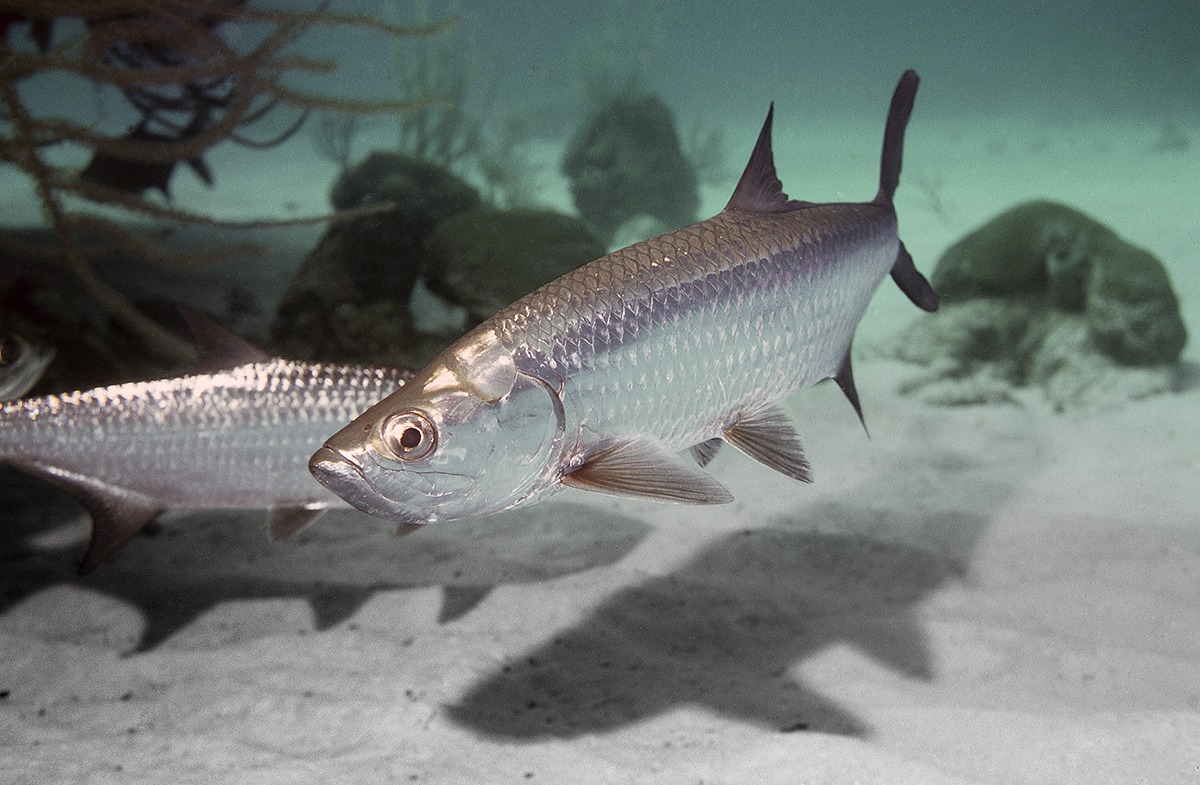
The word “Tarpon” conjures images from fishing lore of large, silvery fish making spectacular leaps out of the water when hooked.
Atlantic tarpon are actually closely related to eels. They may not look at all like their cousins when adults, but their larval stages are considerably more similar.
Also known as “the silver king,” tarpon are found in the Atlantic Ocean from North Carolina south to Brazil, throughout the Caribbean and the Gulf of Mexico. A population is now established on the Pacific side of central and northern South America. These large fish can grow up to 8 feet in length, but they weigh an average 25 to 80 pounds.
In North Carolina waters, the largest tarpon caught was in 2008 off the Sea View Pier in North Topsail Beach by Malcolm Condie and weighed 193 pounds, 5 ounces.
This species is frequently found nearshore and in mangrove creeks. Tarpon are encountered by divers at dive locations like “Tarpon Alley” off the northern side of Grand Cayman Island in the Caribbean. Divers can easily approach tarpon to get a closer look, providing no sudden movements are made. Being in the water so close to these beautiful fish was humbling. Some dwarfed my own size. I was glad they do not like the taste of people!
Tarpon biology
“Atlantic tarpon use a variety of coastal habitats, including wetlands, creeks, freshwater rivers, estuaries and the ocean. They can live in full freshwater and full seawater and can tolerate areas with low oxygen by gulping air at the surface,” said Dr. Aaron J. Adams, director of science and conservation with the Bonefish and Tarpon Trust in Miami, Florida.
Tarpon are a tropical species but also thrive in the subtropics and seasonally move into temperate areas during the warm summer months, Adams said. “They can’t survive water temperatures below 50 degrees, and if the water is already cool, a strong cold front that drops the water temperature quickly can also kill them.”
Tarpon are members of a group of fish whose larval stage are clear or translucent, ribbon-shaped animals. Other fish belonging to this group include tenpounders, bonefishes and eels.
“Atlantic tarpon spawn seasonally, between May and August, generally near the full moon. During spawning season, tarpon have been observed swimming in a circular, rotating manner that recreational anglers call a daisy chain,” Adams said.
“Scientists speculate that this behavior could be a response to predators or could be a pre-spawning activity. Near full moons during spawning season, large schools, often, between 25 to 200 individuals, will move offshore into deep water to spawn. They are broadcast spawners, ejecting their eggs and milt in the open water, where the eggs are fertilized,” Adams said. “These fish have a very high egg generation rate, and large females may produce more than 12 million eggs and likely spawn more than once in a spawning season. The eggs hatch in about a day, and the larvae live as plankton in the open ocean for about a month before moving inshore toward juvenile nursery habitats.”
After being spawned near the edge of the continental shelf, tarpon eggs and larvae begin to grow and drift toward potential nursery habitats. Hatching at a size of about a quarter-inch, the larvae take 20-30 days to complete their development through their leptocephalus, or “slender head” stage while feeding on gelatinous “marine snow” as they grow to about an inch in length.
“These larvae have a clear, transparent broad ribbon-like shape, tiny head and fang-like teeth. Throughout their development, they’re drifting with the prevailing currents, and if they’re lucky, they end up near an estuarine inlet about the time they are ready to move into a nursery marsh. Wind-driven onshore flow, including being pushed by hurricanes, may allow high numbers of larvae to reach a nursery,” said Adams.
As they move onshore, larvae begin undergoing a physiological change into a juvenile form which has adapted to live in coastal marshes. Unlike the larvae of most fishes, larval tarpon, along with their bonefish, ladyfish, and eel relatives, actually shrink as they use the energy and nutrients in their bodies to fuel the development of a new body form.
“Within a few days, as they move into upper marsh habitats, they are less than three-quarters of an inch long, but have begun to grow juvenile body features — fins, including the dorsal, or top fin, and filament characteristics of tarpon, a swim bladder for buoyancy and ultimately air breathing, modified laws and gut. These early juveniles then begin feeding on small plankton, and mosquito larvae. Within four to five weeks, they develop their scales and silver pigment, reach 1½ inches long and look like a real tarpon,” Adams said.
Tarpon become sexually mature between 7 and 12 years of age. As with many species, males tend to become mature at earlier ages and smaller sizes.
“We’ve captured males exuding milt during spawning seasons, for example, that were only 50 inches in length. Tarpon have been aged as old as 80 years,” said Adams.
An Atlantic tarpon’s favorite foods include Atlantic needlefish, pinfish, along with numerous species of shrimp and crabs, dependent upon where they are hunting throughout their range. They will pursue their prey both during the day and at night.
Tarpon management
According to Chris Batsavage, special assistant for councils with the North Carolina Division of Marine Fisheries, this species is currently not being managed by the state, South Atlantic Marine Fisheries Council or the Atlantic States Marine Fisheries Commission.
“The commercial sale of Atlantic tarpon is illegal in the state, and there is a proposal to make the current one-fish-per-day recreational limit changed to catch and release only,” he said. “The final approval of the rule change, should be made within the next 12 months.”
Catch and release
“The Bonefish and Tarpon Trust voiced its support at the N.C. Marine Fisheries Commission by highlighting findings from our Bonefish and Tarpon Trust tarpon-tagging project showing that tarpon migrate into North Carolina each summer,” said Lucas Griffin, postdoctoral research associate at the University of Massachusetts Amherst. “Considering our project highlights tarpon connectivity across jurisdictional lines, tarpon conservation and management should be adopted across states to protect the fishery as a whole. Catch-and-release-only regulations are a critical first step to ensure tarpon are able to safely navigate across the Gulf of Mexico and southeastern U.S. to complete both spawning and foraging migrations.”
To date, only Florida and Virginia are catch-and-release only, if North Carolina adopts this practice it will only be the third state in this endeavor and offer a proactive management strategy, Griffin said.
“This is especially relevant considering tarpon migrations may shift in range with warmer sea surface temperatures expected in the future and, thus, angling pressure,” said Griffin.
Griffin co-authored the trust’s catch-and-release guidelines for tarpon.
Suggested catch-and-release procedures for Atlantic tarpon more than 40 inches fork length include the following two key points:
- Do not remove them from the water. This causes too much damage and stress, and decreases their chances of survival.
- Minimize the time you handle the fish in the water next to the boat before release.
Florida regulations prohibit removing tarpon more than 40 inches from the water.
“For tarpon smaller that 40 inches fork length, minimize handling, since this can remove protective slime from the fish. If you handle a fish, use clean, wet hands.
If you hold the fish out of the water, support the fish beneath the head and belly.
Minimize exposure to air. If you want a photo, get the shot set up before removing the fish from the water. If the fish is not still dripping water in the photo, it has been out of the water too long. Avoid using mechanical lip-gripping devices on active fish, since this can cause jaw injury,” Griffin said.
If a tarpon’s weight is desired, measure the length and girth and use a chart to estimate its weight. Keep fingers away from the gills; damaged gills make it hard for the fish to breathe. If a fish loses equilibrium, meaning if it rolls over or goes nose-down on the bottom, revive it until it can swim upright, then shorten the fight time on future fish. When reviving a fish, be sure that water passes over the gills from front to back. Move the tarpon forward or hold it upright in the water allowing it to pump water through its gills. In warmer water, reduce fight and handling time, the guidelines suggest.
“When fishing with bait, use circle hooks. If a hook is deep within the throat, cut the line as close to the hook as possible this causes less damage than removing a deeply-set hook. Most fish are able to reject the hook or the hook dissolves over time. Keep the fight short. Long fight times result in an exhausted tarpon, which is more vulnerable to predators. Use tackle that matches the fish and conditions,” said Griffin.
Since predators can decrease survival of fish after release, when predators become abundant and appear to be attracted to your fishing activity, Griffin recommends moving to another fishing location. If a shark appears while you are fighting a tarpon, break the tarpon off so it has a chance to escape the shark before it is too tired, he said.
Field identification is easy. Tarpon have very large silvery scales, which resemble armor from the days of knighthood. They have a large scoop shaped mouth, deeply forked tails and a single strand ray which trails off the back, bottom side of the dorsal fin. A very graceful and elegant creature to observe, and boy, are they powerful!




